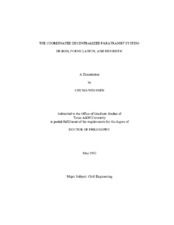| dc.description.abstract | This dissertation investigates the different organizational structures of paratransit services that cover large regions. A paratransit service is demand-responsive, shared-ride transit service using vans or small buses. It is characterized by the use of vehicles that do not operate on a fixed route or a fixed schedule. The paratransit route and schedule are arranged from a user-specified origin to a user-specified destination, and at a user-specified time.
To retain productivity by focusing on shorter trips within a denser area, some larger systems have outsourced operations to more than one contractor, with each contractor responsible for the service zone to which their vehicles have been assigned. This service design is called a "zonal structure" or a "zoning approach."
The zoning with transfer system coordinates vehicles' schedules at various transfer locations. The schedule coordination of inter-zonal mechanisms of transportation likely reduces trip costs by increasing the ridesharing rate and lowering the number of empty return miles.
This study first presents the exact formulation for a coordinated decentralized paratransit system in order to compare its productivity and service quality with independent decentralized and centralized strategies. The formulation is then proven to work correctly, and the results of the computational experiments of small scale instances are shown to demonstrate that the proposed coordinated system is superior to independent decentralized systems in terms of passenger miles per vehicle revenue mile.
In the second section, this study develops an insertion-based heuristic method in order to compare the performances of different operational designs when applied to a large-scale system. In an experiment utilizing Houston's demand-responsive service data, we compare the productivity and service levels among three organizational structures: zoning with transfer, zoning without transfer, and no-zoning designs.
The results indicate that zoning with transfer can provide significant benefits to paratransit operations that manage zoning structure; however, the no-zoning strategy used by Houston METRO (a relatively low-density region) performs better on average in terms of efficiency. This study concludes that the zoning with transfer method can be proven to be a productive organizational structure. | en |


